£1bn regeneration masterplan for Dundee's waterfront
- Published

City planners have been developing a masterplan for the future of Dundee's waterfront since 2001
With an international museum, a new train station, a marina and an enormous park all in the pipeline, there is no end to the ambition in the masterplan city planners have drawn up for the Dundee waterfront. They are even looking at building an urban beach which doubles as an ice rink.
Those behind Dundee's £1bn waterfront regeneration programme forecast it will create 9,000 jobs, attract hundreds of thousands of tourists, and bring in millions of pounds of investment.
At the same time they say it will tempt everything from oil rigs to cruise liners and yachters to travel up the Tay.
"People always laugh about the beach," admits Allan Watt, waterfront project co-ordinator.
"But in winter you could take away the sand and replace it with this new plastic surface that people can ice skate on.
"So you'd have a beach that in winter would become an ice rink."
It is far from the biggest part of the project, but it underlines the breadth and depth of the vision planners have painstakingly constructed over the past decade.
The waterfront project can trace its roots back to 2001, when the local authority held a consultation with residents and businesses about the future of the area, drawing up the masterplan Mr Watt calls a "pact with the public".
Long before plans had been dreamt up to build an outpost of the Victoria and Albert museum in the city, now at the heart of the project, the council was considering how to completely redefine the city's long-standing relationship with the Tay.
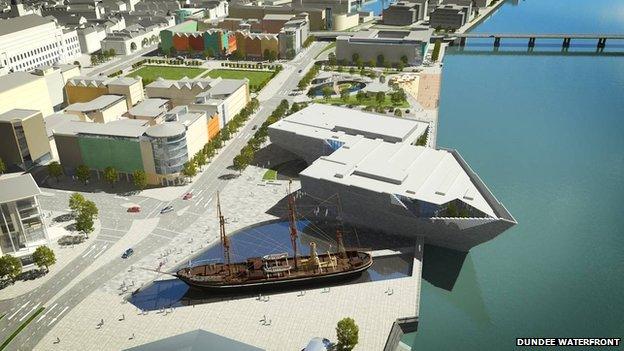
The V&A at Dundee museum and the RRS Discovery stand at the heart of the vision for the waterfront
'Ludicrously ideal'
"The city's growth has been built on its relationship with the river - fishing, whaling, the jute industry and then ship-building," Mr Watt says.
"But when the Tay Road Bridge was built in 1966 the access road network unintentionally cut the city centre off from the waterfront.
"It created a confusing and negative image, and the area became grossly under-utilised.
"The waterfront is the front door to the city, and what did people used to see? The old railway station, not exactly a landmark; the old Olympia swimming pool, which had seen better days; and the Tay Hotel, which at the time was falling apart."
But behind the crumbling facade, planners saw the city's potential - Mr Watt likes to quote former Dundee University rector Stephen Fry, who described the city's setting as "ludicrously ideal".
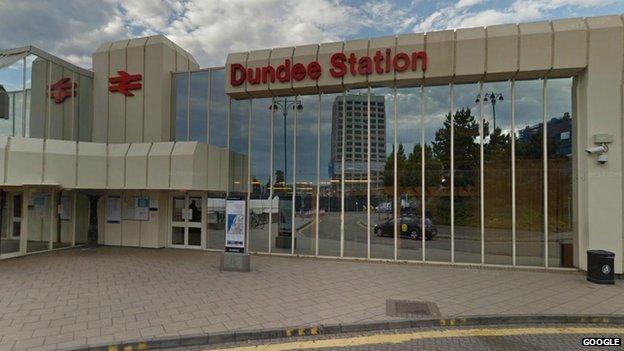
Tayside House, reflected in the city's old railway station, was voted the city's least-loved building

The new £14m train station will open out onto the V&A, Discovery Point and the new Malmaison hotel
In the past 12 months, five major demolition projects have created a clean slate, leaving the masts of Captain Scott's RRS Discovery, moored at Discovery Point, the sole remaining landmark in the area.
Towering former council headquarters Tayside House, once voted the least-loved building in the city, was the first to be torn down - brick-by-brick rather than in a grand detonation, given its position straddling the main east coast train line.
It was followed by the city's dilapidated railway station, which will be replaced by a £14m five-storey complex complete with shops and a hotel. A series of precarious demolition projects had to be carried out over consecutive Christmas holidays for fear of blocking the tracks.
Next to go were the Hilton Hotel and Gala Casino, followed by the old Olympia swimming pool after its £31.5m replacement opened nearby.
The land formerly occupied by those buildings is now being cleared for the construction of the V&A at Dundee museum, a £45m centre of design created by renowned Japanese architect Kengo Kuma.
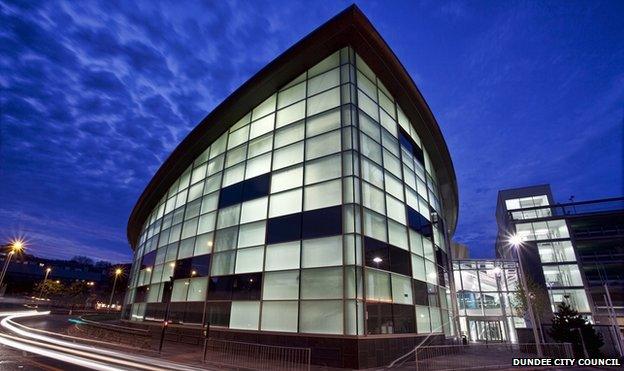
The new £31.5m Olympia swimming pool has cleared the way for the V&A at Dundee at its former home
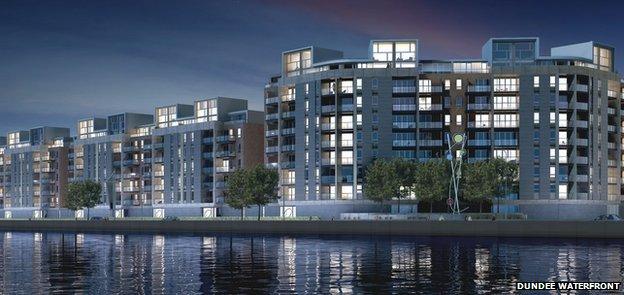
New flats being built along Riverside Drive are set to go on the market within weeks
It is projected the V&A could bring 500,000 extra tourists to Dundee in its inaugural year in 2017, with 300,000 more following every year thereafter.
Several hotel firms have already spotted the potential market developing in the city, and Malmaison opened a new luxury location in the former Tay Hotel building right across the road from the museum site earlier this year, after a £15m refurbishment.
Creative sector
Permanent residents are also expected to move in, to fill the slew of new jobs created. New housing is being built along Riverside Drive, with flats set to go on the market within weeks.
And Mr Watt has had "serious discussions" with property firms about the central waterfront, with hundreds of flats potentially in the offing, along with a mix of bars, cafes and shops to keep the area busy through the day and night.
There are also plans for more housing towards the west end of the city and the Seabraes area, which is also home to the city's burgeoning creative and life sciences sector.
The city which spawned Grant Theft Auto and Lemmings is looking to build on a growing reputation - Mr Watt wants it to be "a place for new businesses to set up and existing ones to expand".
This is where District 10 comes in, a futuristic-looking office block built out of old shipping containers on a former railway yard at Seabraes. Existing office space has already been snapped up by a number of innovative local businesses and entrepreneurs, many of whom trade internationally, and more blocks are set to follow.

The District 10 building houses creative industries in offices made from old shipping containers
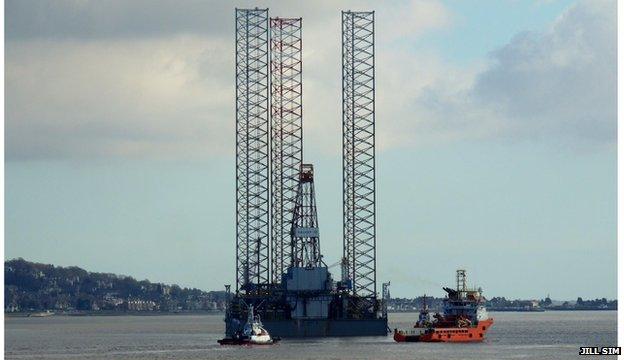
Dundee's port already regularly hosts North Sea rigs which head up the Tay for repairs and maintenance
'Open for business'
Dundee's port plays a vital role in the masterplan, second only perhaps to the central waterfront itself.
The area is already attracting investment, with a new oil rig repair and maintenance facility recently announced, and it has been singled out by the Scottish government's National Renewables Investment Plan as a top location in Scotland for manufacturing and maintaining offshore wind turbines.
Thanks to improvements to the local road network, one shipment of giant wind turbine parts built in Scandinavia has already passed through the city's port, bound for Aberdeenshire, and Mr Watt has designs on attracting more - or even seeing them built locally.
He said: "We are open for business and I think we'll see more turbines passing through. A number of companies are now talking to Forth Ports about that.
"The offshore turbines are so big they can't be transported by road or rail in the UK - but they could be manufactured right on the quayside here and shipped straight out to the wind farms.
"We're beautifully placed to play into that."

Open spaces at the heart of the waterfront include an urban beach, which would become an ice rink in winter
As part of the bid to house offshore wind farm maintenance vessels, the city council is in negotiations with Forth Ports to take over the lock at City Quay.
With the lock currently broken and stuck shut, the only vessels inside the quay are the HM Frigate Unicorn, the world's sixth oldest ship, now converted into a museum, and another historical curio in the North Carr, Scotland's last lightship - but Mr Watt has much grander plans for the area.
Not only is the new lock being designed with the specifications of offshore service vessels in mind, planners hope to build a thriving marina in the waters of City Quay.
"I've spoken to consultants who say there's massive need for berthing of yachts in this part of Scotland," said Mr Watt.
"There can't be many cities in the UK where you can sail straight into the heart of the city - you'd be five minutes walk from the V&A, and not many places could boast that."
- Published31 March 2014
.jpg)
- Published4 February 2014
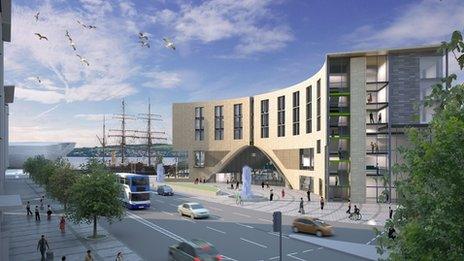
- Published1 October 2013
